| Okra - Abelmoschus esculentus - North American Cultivars | |
|---|---|
| Back
to Okra Page 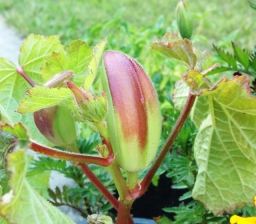 |
'Alabama Red' (Fig.
1) Heirloom. A chunky sized okra bearing large, blocky pods with a red and light green color. Colorful, tasty and a delicious Southern specialty. Days to Harvest: 70 1 'Annie Oakley II' Hybrid. Spineless dwarf plants, tender to 4½ in. (11 cm), bright green pods. Seed per row 100 ft (30 m): 2 oz (57 g) Days to Harvest: 48 6 'Bhutanese' Produces green pods, eaten when 3-5 in. (7-13 cm) long. Pods become hairy and spiny when mature. 2 |
 |
'Blondy'
(Fig. 2) An All-America Selections (AAS) Winner in 1986. 'Blondy' is the first dwarf, white-podded okra with a flower similar to a small hibiscus bloom. 'Blondy' is early and productive providing gardeners with abundant okra for popular French and Creole cooking. 4 'Borneo' This variety produces extra long edible pods that can be up to 18 in. (45 cm) long. 2 |
 |
'Bowling
Red' (Fig. 3) Heirloom, dates
back to at least the 1920's. This is one of the longer fruited varieties, tender with great flavor. 1 |
 |
'Burgundy'
(Fig. 4) An All-America Selections (AAS) Winner in 1988. Judges scored Okra 'Burgundy' for its higher yield, plant uniformity, unique color and improved quality. 'Burgundy' presents a pretty contrast between the plant’s green leaves against the burgundy stems, branches, leaf ribs and fruits—and a pretty display of yellow-cream flowers. Pods should be harvested ast 3-4 in. (7-10 cm) when they are young and tender. 4 |
 |
'Burmese'
(Fig. 5)
Heirloom. A wonderful okra from Asia, bearing nearly spineless pods up to 12 in. (30 cm) long. A less mucilaginous variety with large 16 in. (40 cm) leaves that bears when plants are 18 in. (45 cm) tall. Pods are slender and ripen to a light green, with hints of yellow. Tender and sweet, can even be eaten raw! Days to Harvest: 53 1,2 |
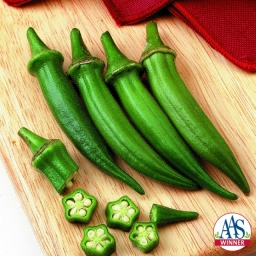 |
'Cajun
Delight' F1
(Fig. 6) An All-America Selections (AAS) Winner in 1997. Green pods remain tender even at 5 in. (12 cm). Large leaves are attractive in flower beds. For best production, pick often at least 2-3 times weekly when the weather is warm. Plant height: to 4 ft (1.2 m) Pod length: best at 3-5 in. (8-12 cm) Days to Harvest: 50-55 4 |
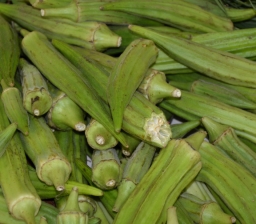 |
'Cajun Jewel'(Fig.
7) A dwarf okra, growing to only 2½-4 ft (0.8-1.2 m) Great for small spaces and early harvests! Bears slender pods up to 8 in. (20 cm) long with a tasty, traditional okra flavor. Popular in the Southern U.S. Days to Harvest: 50-55 1 'Cajun King' Developed by a Cajun to sell at market and passed down among locals. Stays tender until up to 15 in. (38 cm) long! Said by many local Cajuns to be the most prolific they have ever grown. Days to Harvest: 58 (from tranplant) 5 'Campbells Long Green' Breeder and vendor: Campbell Soup Company, Riverton, N.J. Parentage: selection from 'Perkins Mammoth'. Characteristics: slender pod, semi-dwarf, high color. Similar: 'Perkins Mammoth'. Adaptation: general. 1940. 7 |
 |
'Candle
Fire' F1 (Fig.
8)
An All-America Selections (AAS) Winner in 2017. Pods that are round, not ribbed, and a brighter red color than the reddish burgundy okras currently available. This high-performing AAS Winner received high marks for productivity, taste, texture and tenderness as well as the ornamental value of red pods on red stems. One judge noted that Candle Fire okra was quite maintenance free to grow, except for the frequent harvesting, which is a great thing! Candle Fire thrives in the heat and is disease resistant even in hot humid climates like the south where it’s perfect for traditional fried okra. Suitable for both fruit producing and ornamental usage. Aged fruit can be used in flower arrangements. Dry seed can be used as coffee (without caffeine). Pod length: 1½ in. (4 cm) Days to Harvest: 60 4 |
 |
'Clemson
Spineless' (Fig. 9) An All-America Selections (AAS)
Winner in 1939. Bears great quantities of dark green pods without spines. Nice flavor, solid yields, and sturdy 4 ft (1.2 m) plants have made this a favorite standard garden okra. ±500 seeds/oz (±14,175 seeds/g) Pods are best at 2-3 in. (5-8 cm) Days to Harvest: 55-60 2,3 'Cow’s Horn' Heirloom dating to the 1800s. Plant height: to 8 ft (2.5 m) Pod length: 14 in. (36 cm), best at 6 in. (15 cm) Seed per row 100 ft (30 m): 2 oz (57 g) Days to Harvest: 55 6 'Dardo' (PS 11589) Breeder and vendor: Seminis Vegetable Seeds-Petoseed. Parentage: F1 hybrid. Characteristics: small plant, leaves more serrated, semi round type for Brazil; early maturing, 30 days earlier than current leader 'Santa Cruz 47'. Similar: 'Santa Cruz 47'. Adaptation: Brazil. 2002. 7 'Dixie Spineless' (NV 2552) Breeder and vendor: Northrup King. Parentage: pure line selection from 'Clemson Spineless'. Characteristics: green stalk, deep cut leaf compared to 'Clemson Spineless', plants slightly taller and more vigorous than 'Clemson Spineless', without anthocyanin in plant or fruit. PVP. 1982. 7 |
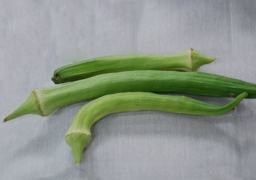 |
'Emerald' (Fig. 10)
A semi-dwarf okra with thick walled, spineless pods. The pods have a tender flavor that is great for all okra uses. Plant height: to 4 ft (1.2 m) Pod length: to to 9 in. (23cm) Days to Harvest: 55 1 'Evergreen' Breeder and vendor: Campbell Soup Company, Riverton, N.J. Parentage: 'Clemson Spineless', 'Lady Finger'. Characteristics: long pod, spineless, slender pod, medium green color, tall plant. Adaptation: general. 1945. 7 'Gold Coast' Breeder and vendor: Louisiana Agric. Expt. Sta., Baton Rouge, Louisiana. Parentage: 'PI 186972' from 'Gold Coast' x 'Louisiana Market'. Characteristics: dwarf plant, straight dark green pod, fruits over a long period, excellent for freezing and local market. Resistance: heat. Similar: 'Louisiana Market'. Adaptation: southern United States. Arc. 57, Louisiana Agric. Expt. Sta., June 1959. 7 |
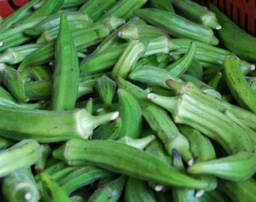 |
'Green Velvet' (Fig.
11) A great okra for high humidity areas, this variety yields flavorful pods up to 4-8 in. (10-20 cm) long. Pods remain an emerald-green throughout their ripening. Plant height: to 6 ft (1.8 m) Days to Harvest: 58 1 'Gumby' A further selection of the 'Prelude' variety of okra. It matures much earlier and at a shorter height than other varieties of okra. 2 |
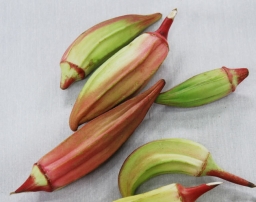 |
'Hill Country Red'
(Fig. 12) Heirloom from Central and South Texas,
unknown date
of
origin. A unique bi-colored okra bearing pods that ripen to lime green, with red accents along tips and ribs. Pods have a variety of uses, with great classic okra flavor and are also good pickled. Pod length: to 3 in. (8 cm) Days to Harvest: 60-70 1 |
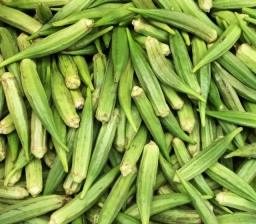 |
'Jade' (Fig. 13) Breeder and vendor: Department of Horticulture and Forestry, University of Arkansas, Fayetteville. Parentage: 'Clemson spineless', 'Emerald', 'Goldcoast', 'Louisiana 97-2-1' and 'PI 248999'. Characteristics: semi-dwarf growth habit, similar in height to 'Clemson 80' but with fewer branches; pods are straight, dark green and ribbed with 6 to 9 locules; matures 10 days earlier than 'Clemson Spineless'. Adaptation: for fresh market, commercial and home garden production. 1990. 7 Seed per row 100 ft (30 m): 2 oz (57 g) Pods up to 5 in. (12 cm) Days to Harvest: 50-56 1,6 'Jambalaya' Hybrid. Dwarf plant, yields well, good for containers, very early. Days to Harvest: 50 6 'Jefferson' Breeder and vendor: Department of Horticulture, University of Arkansas, Fayetteville. Parentage: 'Clemson Spineless', 'L97-2-1', 'Emerald', 'Perkins', 'Goldcoast' and 'PI 248999'. Characteristics: plants tall, 6 and relatively free of lateral branches, leaves medium lobed, pods dark green, 7-9 carpels, few spines, early. Adaptation: processing, fresh market. 1981. 7 |
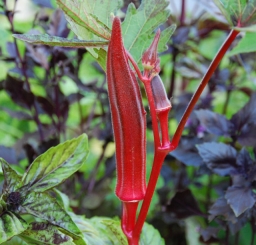 |
'Jing Orange' (Fig.
14)
A rare okra producing deep red-orange pods. Beautiful coloring lends the plant to being a fun ornamental along with its tasty and edible pods. Days to Harvest: 60 1 'Lee' Breeder and vendor: Department of Horticulture, University of Arkansas, Fayetteville. Parentage: 'Gulfcoast', 'PI 248999', 'Emerald' and 'Clemson Spineless'. Characteristics: plants are semi-dwarf and generally free of lateral branches, leaves are slightly lobed, pods are 5 carpellate, uniform, straight, bright green and spineless. 1978. 7 Seed per row 100 ft (30 m): 2 oz (57 g) Days to Harvest: 55 6 'Little Lucy' (PS 38895) An All-America Selections (AAS) Winner in 1998. Breeder: Jim Waltrip. Vendor: Seminis Vegetable Seeds-Petoseed. Parentage: F1 hybrid. Characteristics: dwarf red okra; ornamental, very attractive plant. Resistance: none noted. Adaptation: home garden; North America. 7 'Louisiana Market' All-America Selections (AAS) trials in 1950. Breeder: Fruit and Truck Sta., Hammond, Louisiana. Vendor: Reuter Seed Co. Parentage: PI accession from Mexico x 'New Orleans Market'. Characteristics: heavy yields of thick, smooth green pods with thick walls; arrangements of petaloids and foliage tend to make pods easily accessible. Adaptation: regions of the southern United States. 7 'Manee Maejo' This variety has two colors, green and light maroon. The pod of this variety is longer than the 'Red maroon' variety. 2 'North and South' (B 56960) Hybrid. Breeder and vendor: Burpee. Characteristics: early yielding, tolerates cool temperatures, pods are dark green with little fiber, fresh market and home garden production. 1995. 7 'Parbhani Kranti' (PBNO 57) Breeder: Central Seeds Organization, Mahatma Phule Agricultural University, Rahuri-413 722, India. Parentage: 'Pusa Sawani' x Abelmoschus manihot and subsequent backcrosses to 'Pusa Sawani' with selection for resistance to yellow vein mosaic virus. Characteristics: plants tall, single stemmed, dark green foliage, fruit are dark green, smooth, slender. Resistance: yellow vein mosaic. 1986. 7 |
 |
'Perkins Long Pod' (Fig.
15)
Vigorous plants can grow to 5 ft (1.5 m). Annual. Days to Harvest: 55 1 'Perkins Spineless' Breeder and vendor: Campbell Soup Company, Riverton, N.J. Parentage: 'Campbell Long Green' x 'Clemson Spineless'. Characteristics: spineless pod, deep-green pod color, deep cut leaves, semi-dwarf, earliness. Similar: 'Campbells Long Green'. Adaptation: general. Seed World. May 18, 1945. 7 'Prelude' (NV 2555) Breeder and vendor: Northrup King and Co. Characteristics: open pollinated, fluted pod; for fresh market and processing; pod is medium dark green, seven to eight carpels. Similar: 'Clemson Spineless'. Adaptation: all okra-producing areas. PVP. 1984. A compact variety with lance-shaped leaves that allow easier harvest and let sunlight pass through the canopy and reach more of the lower leaves. 2,7 Pod length: 3-5 in. (7-13 cm) Days to Harvest: 48 'Pusa Makmahli' A quick maturing okra from Northern India with light green pods. Plant height: to 10 ft (3 m) 2 |
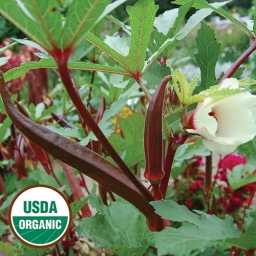 |
'Red Burgundy' (Fig.
16) An All-America Selections (AAS) Winner in 1988. This variety will grow well in most regions of the United States but does not tolerate cold well. Aka 'Burgundy'. Bred by Leon Robbins at Clemson University after eight years of careful selection. Introduced in 1983. Stunning plant with burgundy accents and tender burgundy pods. Good yields, annual or perennial. ±500 seeds/oz (±14,175 seeds/g) Plant height: to 4 ft (1.2 m) Pod length: 6 in. (15 cm Days to Harvest: 55-60 3 'Red Maroon' Produces dark red pods that can reach 7.8 in. (20 cm) but are eaten when 4.7-6 in. (12-15 cm) long. 2 |
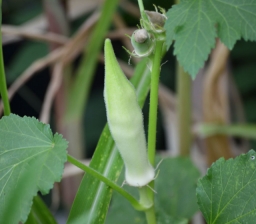 |
'Silver Queen' (Fig.
17) A unique and prized variety of Okra, notable for its long, white-green pods, with a tender but rich flavor when young, distinct from many common okra's. Produces very well. Pod length: to 6 in. (15 cm) Days to Harvest: 80 1 |
 |
'Simpson'
(Fig. 18) The straight, green, downy pods of this variety are intermediate in length and width. Seed Savers Exchange member Dr. James Wolfe received the variety from the Simpson family of Rogersville, Tennessee. D. V. (Simpson) Thomas remembers her mother, Nora, growing this okra as far back as the early 1940s. Pod length: best under 5 in. (12 cm) Days to Harvest: 50-70 3 |
 Back to Okra Page |
'Star of David'
(Fig. 19) Originally from Israel, the fruit has a great and distinctive flavor. This variety will grow well in most regions of the United States does not tolerate cold well. Plants have purple coloration on leaves. Plant height: to 7 ft (2.2 m) Pod length: best at 3 in. (8 cm) Days to Harvest: 60-75 3 'White Lightning' Breeder and vendor: H. G. Hastings Company, Atlanta. Parentage: 'White Velvet'. Characteristics: long, slender, white pods, tender. Similar: 'White Velvet'. Adaptation: southern U.S. Hastings Catalog, 1939. 7 |
| Bibliography 1 "Okra." Trade Winds Fruit, www.tradewindsfruit.com/okra/. Accessed 29 July 2020. 2 "Okra Varieties." Echo community, www.echocommunity.org/en/plants/4/plant_varieties. Accessed 30 July 2020. 3 "Okra." Seed Savers Exchange, www.seedsavers.org/category/okra. Accessed 31 July 2020. 4 "Okra." AAS Winners, All-America Selections, all-americaselections.org/product-category/edibles-vegetables/okra/. Accessed 31 July 2020. 5 "Cajun King Okra." The Florida Backyard Vegetable Gardener, Growin Crazy Acres, growincrazyacres.com/seed-store-2/okra/cajun-king-okra/. Accessed 8 Aug. 2020. 6 Andersen, Craig R. "Okra." Home Gardening Series, University of Arkansas, www.uaex.edu/publications/pdf/FSA-6013.pdf. Accessed 2 Aug. 2020. 7 "Vegetable Cultivar Descriptions for North America – Okra. Lists 1-27 Combined." Cucurbit Genetics Cooperative, Edited by Robert L. Jarret, 2 June 2016, CGC, cucurbit.info/2016/06/okra/. Accessed 16 Aug. 2020. Photographs Fig. 1 "Alabama Red Okra." Trade Winds Fruit, www.tradewindsfruit.com/alabama-red-okra-seeds. Accessed 29 July 2020. Fig. 2 "Okra Blondy." AAS Winners, All-America Selections, all-americaselections.org/product/okra-blondy/. Accessed 1 Aug. 2020. Fig. 3 "Bowling Red Okra." Trade Winds Fruit, www.tradewindsfruit.com/abelmoschus-esculentus-bowling-red-okra-seeds. Accessed 29 July 2020. Fig. 4 "Okra Burgundy." AAS Winners, All-America Selections, all-americaselections.org/product/okra-burgundy/. Accessed 1 Aug. 2020. Fig. 5 "Burmese Okra." Trade Winds Fruit, www.tradewindsfruit.com/abelmoschus-esculentus-burmese-okra-seeds. Accessed 29 July 2020. Fig. 6 "Okra Cajun Delight F1." AAS Winners, All-America Selections, all-americaselections.org/product/okra-cajun-delight/. Accessed 30 July 2020. Fig. 7 "Cajun Jewel Okra." Trade Winds Fruit, www.tradewindsfruit.com/cajun-jewel-okra-seeds. Accessed 29 July 2020. Fig. 8 "Okra Candle Fire F1." AAS Winners, All-America Selections, all-americaselections.org/product/okra-candle-fire/. Accessed 31 July 2020. Fig. 9 "Clemson Spineless Okra." AAS Winners, All-America Selections, all-americaselections.org/product/okra-clemson-spineless/. Accessed 1 Aug. 2020. Fig. 10 "Emerald Okra." Trade Winds Fruit, www.tradewindsfruit.com/emerald-okra-seeds. Accessed 29 July 2020. Fig. 11 "Green Velvet Okra." Trade Winds Fruit, www.tradewindsfruit.com/green-velvet-okra-seeds. Accessed 29 July 2020. Fig. 12 " Hill Country Red Okra." Trade Winds Fruit, www.tradewindsfruit.com/hill-country-red-okra-seeds. Accessed 29 July 2020. Fig. 13 "Jade Okra." Trade Winds Fruit, www.tradewindsfruit.com/abelmoschus-esculentus-jade-okra-seeds. Accessed 29 July 2020. Fig. 14 "Jing Orange Okra." Trade Winds Fruit, www.tradewindsfruit.com/jing-orange-okra-seeds. Accessed 29 July 2020. Fig. 15 "Perkins Long Pod Okra." Trade Winds Fruit, www.tradewindsfruit.com/perkins-long-pod-okra-seeds. Accessed 29 July 2020. Fig. 16 "Red Burgundy Okra." Seed Savers Exchange, www.seedsavers.org/red-burgundy-organic-okra. Accessed 31 July 2020. Fig. 17 "Silver Queen Okra." Trade Winds Fruit, www.tradewindsfruit.com/silver-queen-okra-seeds. Accessed 29 July 2020. Fig. 18 "Simpson Okra." Seed Savers Exchange, www.seedsavers.org/Simpson Okra. Accessed 31 July 2020. Fig. 19 "Star of David Okra." Seed Savers Exchange, www.seedsavers.org/star-of-david-organic-okra. Accessed 31 July 2020. Published 16 Aug. 2020 KJ |
|